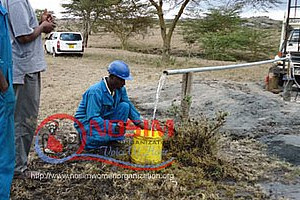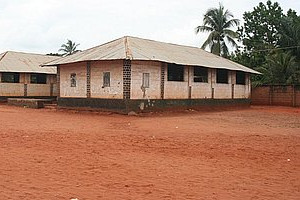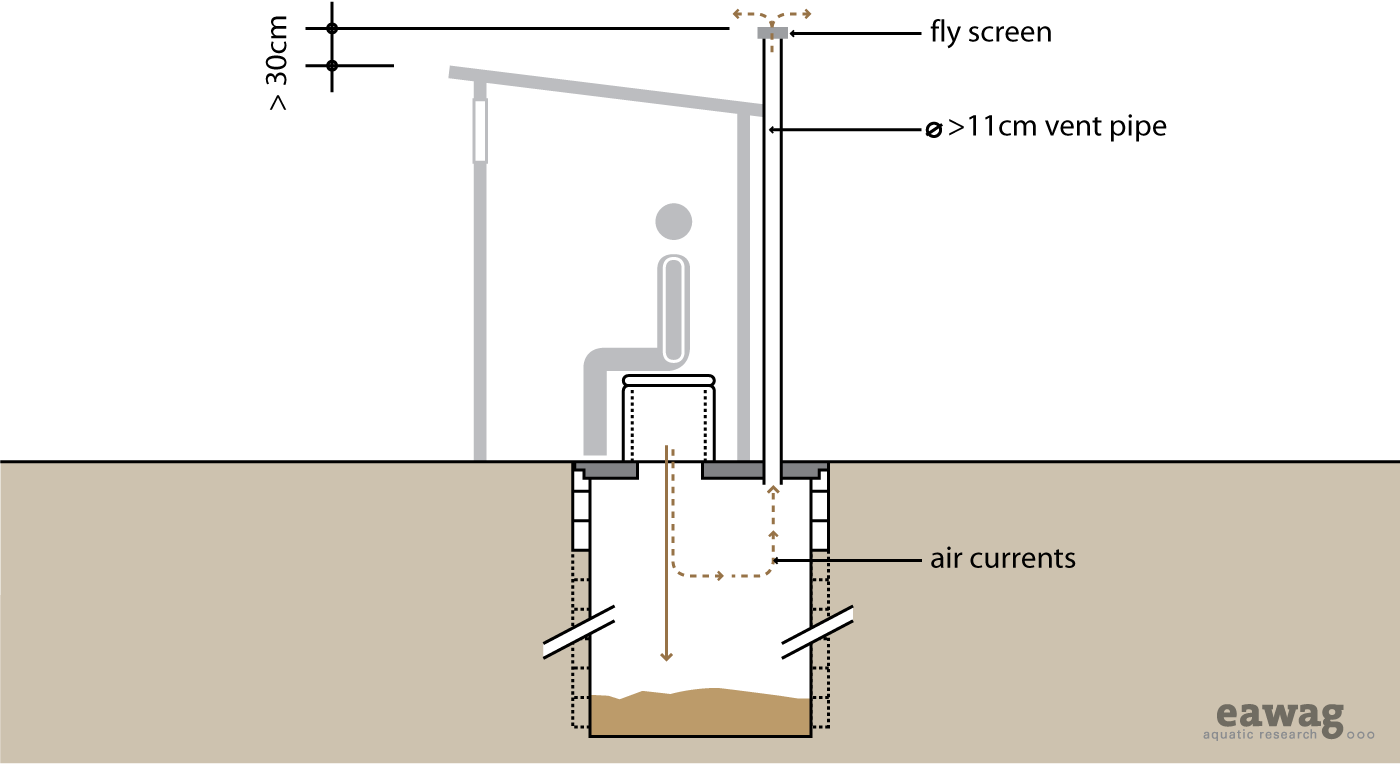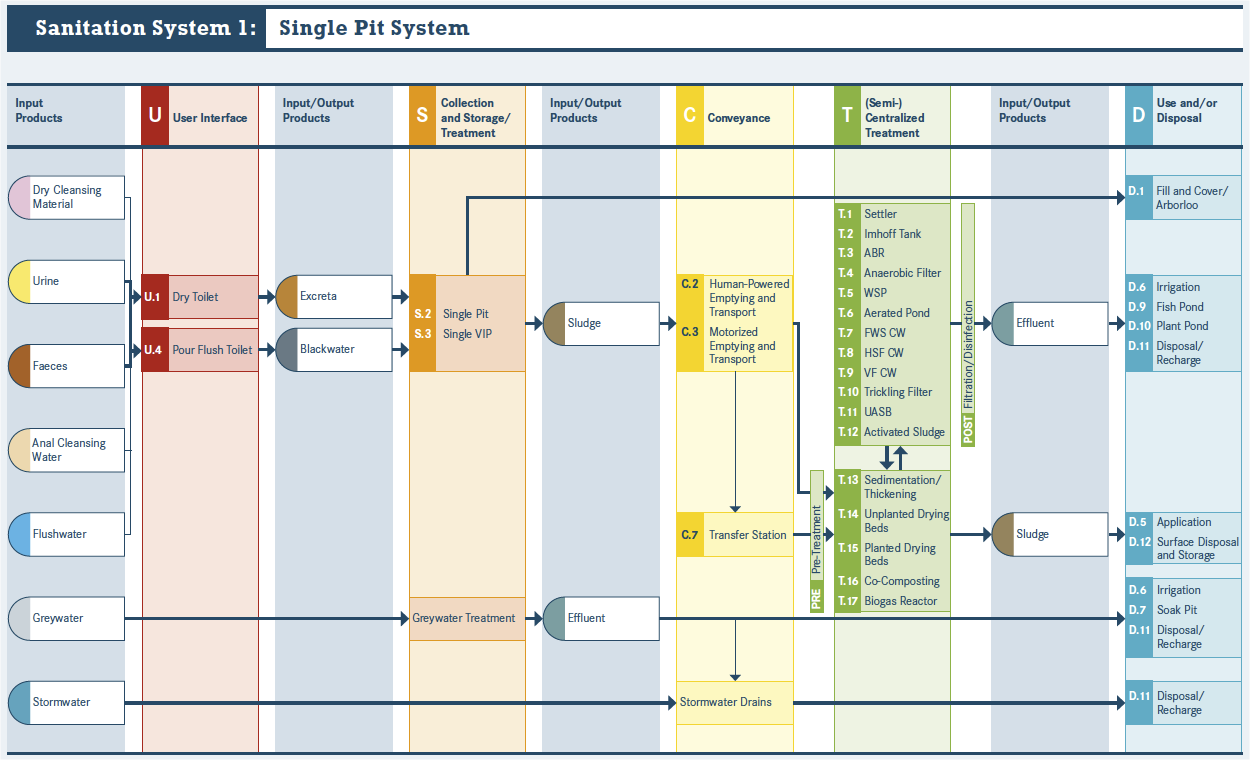Difference between revisions of "Single Ventilated Improved Pit"
(→Field experiences) |
|||
| Line 32: | Line 32: | ||
<br> | <br> | ||
[[Image:Icon_single_ventilated_improved_pit.png |right|80px]] | [[Image:Icon_single_ventilated_improved_pit.png |right|80px]] | ||
| − | '''The Single VIP is a | + | '''The Single VIP is a ventilated, improved pit. It is an improvement over the Single Pit (S.2) because continuous airflow through the ventilation pipe vents odours and acts as a trap for flies as they escape towards the light.''' |
| − | Despite their simplicity, well-designed | + | Despite their simplicity, well-designed single VIPs can be completely smell free, and more pleasant to use than some other water-based technologies. Flies that hatch in the pit are attracted to the light at the top of the ventilation pipe. When they fly towards the light and try to escape, they are trapped by the flyscreen and die. The ventilation also allows odours to escape and minimizes the attraction for flies. |
| − | + | '''Design Considerations:''' The vent pipe should have an internal diameter of at least 110 mm and reach more than 300 mm above the highest point of the toilet superstructure. Wind passing over the top creates a suction pressure within the vent pipe and induces an air circulation. Air is drawn through the User Interface into the pit, moves up inside the vent pipe and escapes into the atmosphere. Care should be taken that objects, such as trees or houses, do not interfere with the air stream. The vent works best in windy areas, but where there is little wind, its effectiveness can be improved by painting the pipe black. The heat difference between | |
| + | the pit (cool) and the vent (warm) creates an updraft that pulls the air and odours up and out of the pit. To test the efficacy of the ventilation, a lit cigarette can be held over the User Interface; the smoke should be pulled down into the pit and up into the vent and not remain in the superstructure. The mesh size of the fly screen must be large enough to prevent clogging with dust and allow air to circulate freely. Aluminium screens, with a hole-size of 1.2 to 1.5 mm, have proven to be the most effective. Typically, the pit is at least 3 m deep and 1 to 1.5 m in diameter, depending on the number of users. Deep pits can last up to 20 or more years. | ||
| − | + | As liquid leaches from the pit and migrates through the unsaturated soil matrix, pathogenic germs are sorbed to the soil surface. In this way, pathogens can be removed prior to contact with groundwater. The degree of removal varies with soil type, distance travelled, moisture and other environmental factors and, thus, it is difficult to estimate the distance necessary between a pit and a | |
| + | water source. A minimum horizontal distance of 30 m between a pit and a water source and 2 m between the bottom of the pit and the groundwater table is normally recommended to limit exposure to microbial contamination. | ||
| − | + | When it is not possible to dig a deep pit or the groundwater level is too high, a raised pit can be a viable alternative: the shallow pit can be extended by building the pit upwards with the use of concrete rings or blocks. A raised pit can also be constructed in an area where flooding is frequent in order to keep water from flowing into the pit during heavy rain. | |
| − | + | A single VIP toilet can be upgraded to a Double VIP (S.4). A Double VIP has an extra pit so that while one is in use, the contents of the full pit are allowed to drain, mature and degrade. If a urine-diverting User Interface is used, only faeces are collected in the pit and leaching can be minimized. | |
| − | |||
| − | |||
<br> | <br> | ||
| − | {{procontable | pro= | + | {{procontable |
| − | - Flies and odours are significantly reduced (compared to non-ventilated pits | + | | pro= |
| − | - | + | - Flies and odours are significantly reduced (compared to non-ventilated pits). <br> - Can be built and repaired with locally available materials. <br> - Low (but variable) capital costs depending on materials and pit depth. <br> - Small land area required. <br> |
| + | | con= | ||
| + | - Low reduction in BOD and pathogens with possible contamination of groundwater. <br> - Costs to empty may be significant compared to capital costs. <br> - Sludge requires secondary treatment and/or appropriate discharge. | ||
}} | }} | ||
| − | |||
| − | Treatment processes in the | + | [[Image:single pit system - compendium.png|none|1000px|]] |
| + | |||
| + | |||
| + | ===Appropriateness=== | ||
| + | Treatment processes in the single VIP (aerobic, anaerobic, dehydration, composting, or otherwise) are limited, and, therefore, pathogen reduction and organic degradation is not significant. However, since the excreta are contained, pathogen transmission to the user is limited. This technology is a significant improvement over Single Pits or open defecation. | ||
| + | |||
| + | Single VIPs are appropriate for rural and peri-urban areas; in densely populated areas they are often difficult to empty and/or have insufficient space for infiltration. VIPs are especially appropriate when water is scarce and where there is a low groundwater table. | ||
| + | They should be located in an area with a good breeze to ensure effective ventilation. They are not suited for rocky or compacted soils (that are difficult to dig) or for areas that flood frequently. | ||
===Health Aspects/Acceptance=== | ===Health Aspects/Acceptance=== | ||
| − | |||
A Single VIP can be a very clean, comfortable, and well accepted sanitation option. However some health concerns exist: | A Single VIP can be a very clean, comfortable, and well accepted sanitation option. However some health concerns exist: | ||
* Latrine leachate can contaminate groundwater; | * Latrine leachate can contaminate groundwater; | ||
| Line 64: | Line 71: | ||
===Upgrading=== | ===Upgrading=== | ||
| − | |||
A Single VIP toilet can be upgraded to a [[Double Ventilated Improved Pit|Double VIP]], a [[Urine Diverting Dry Toilet|Urine Diverting Dry Toilet (UDDT)]] if there is a use for urine, or a water-based [[Pour Flush Toilet|Pour Flush Toilet]] if water is available. A Double VIP has the addition of an extra pit so that while one pit is in use, the contents of the full pit are draining, maturing and undergoing degradation. Pathogens are destroyed much more thoroughly in a Double VIP and therefore, the contents are less hazardous to remove from the pit, although because the contents are so solid, the contents cannot be pumped, but rather, must be manually emptied. | A Single VIP toilet can be upgraded to a [[Double Ventilated Improved Pit|Double VIP]], a [[Urine Diverting Dry Toilet|Urine Diverting Dry Toilet (UDDT)]] if there is a use for urine, or a water-based [[Pour Flush Toilet|Pour Flush Toilet]] if water is available. A Double VIP has the addition of an extra pit so that while one pit is in use, the contents of the full pit are draining, maturing and undergoing degradation. Pathogens are destroyed much more thoroughly in a Double VIP and therefore, the contents are less hazardous to remove from the pit, although because the contents are so solid, the contents cannot be pumped, but rather, must be manually emptied. | ||
| − | ===Maintenance=== | + | ===Operation & Maintenance=== |
| − | |||
To keep the Single VIP free of flies and odours, regular cleaning and maintenance is required. Dead flies, spider webs, dust and other debris should be removed from the ventilation screen to ensure a good flow of air. | To keep the Single VIP free of flies and odours, regular cleaning and maintenance is required. Dead flies, spider webs, dust and other debris should be removed from the ventilation screen to ensure a good flow of air. | ||
| Line 75: | Line 80: | ||
===Field experiences=== | ===Field experiences=== | ||
| − | |||
{{RSR_table | {{RSR_table | ||
|1image= rsr 476.jpg|1link=http://rsr.akvo.org/project/476/ |1project#=476 |1project name=Ensure access to safe water and sanitation | | |1image= rsr 476.jpg|1link=http://rsr.akvo.org/project/476/ |1project#=476 |1project name=Ensure access to safe water and sanitation | | ||
| Line 85: | Line 89: | ||
===References === | ===References === | ||
| − | + | * Mara, D. D. (1984). The Design of Ventilated Improved Pit Latrines. UNDP Interregional Project INT/81/047, The World Bank and UNDP, Washington, D.C., US. Available at: documents.worldbank.org/curated/en/home | |
| − | * Mara, | + | * Mara, D. D. (1996). Low-Cost Urban Sanitation. Wiley, Chichester, UK. (Provides detailed design information) |
| − | + | * Morgan, P. R. (2009). Ecological Toilets. Start Simple and Upgrade from Arborloo to VIP. Stockholm Environment Institute, | |
| − | + | Stockholm, SE. Available at: www.ecosanres.org | |
| − | + | * Morgan, P. R. (2011). The Blair VIP toilet. Manual for Upgradeable BVIP Model with Spiral Superstructure and Tubular Vent. Stockholm Environment Institute, Stockholm, SE. Available at: www.ecosanres.org (Provides detailed design and construction information) | |
| − | + | * Ryan, B. A. and Mara, D. D. (1983). Ventilated Improved Pit Latrines: Vent Pipe Design Guidelines. UNDP Interregional Project INT/81/047, The World Bank and UNDP, Washington, D.C., US. Available at: documents.worldbank.org/curated/en/home | |
| − | + | See S.2 for additional reading materials. | |
| − | * | ||
| − | |||
| − | * Morgan | ||
| − | |||
| − | * Morgan | ||
| − | |||
| − | |||
| − | |||
| − | * | ||
| − | |||
| − | |||
===Acknowledgements=== | ===Acknowledgements=== | ||
{{:Acknowledgements Sanitation}} | {{:Acknowledgements Sanitation}} | ||
Revision as of 00:25, 27 September 2014
|
|||||||||||||||||||||||||||
The Single VIP is a ventilated, improved pit. It is an improvement over the Single Pit (S.2) because continuous airflow through the ventilation pipe vents odours and acts as a trap for flies as they escape towards the light.
Despite their simplicity, well-designed single VIPs can be completely smell free, and more pleasant to use than some other water-based technologies. Flies that hatch in the pit are attracted to the light at the top of the ventilation pipe. When they fly towards the light and try to escape, they are trapped by the flyscreen and die. The ventilation also allows odours to escape and minimizes the attraction for flies.
Design Considerations: The vent pipe should have an internal diameter of at least 110 mm and reach more than 300 mm above the highest point of the toilet superstructure. Wind passing over the top creates a suction pressure within the vent pipe and induces an air circulation. Air is drawn through the User Interface into the pit, moves up inside the vent pipe and escapes into the atmosphere. Care should be taken that objects, such as trees or houses, do not interfere with the air stream. The vent works best in windy areas, but where there is little wind, its effectiveness can be improved by painting the pipe black. The heat difference between the pit (cool) and the vent (warm) creates an updraft that pulls the air and odours up and out of the pit. To test the efficacy of the ventilation, a lit cigarette can be held over the User Interface; the smoke should be pulled down into the pit and up into the vent and not remain in the superstructure. The mesh size of the fly screen must be large enough to prevent clogging with dust and allow air to circulate freely. Aluminium screens, with a hole-size of 1.2 to 1.5 mm, have proven to be the most effective. Typically, the pit is at least 3 m deep and 1 to 1.5 m in diameter, depending on the number of users. Deep pits can last up to 20 or more years.
As liquid leaches from the pit and migrates through the unsaturated soil matrix, pathogenic germs are sorbed to the soil surface. In this way, pathogens can be removed prior to contact with groundwater. The degree of removal varies with soil type, distance travelled, moisture and other environmental factors and, thus, it is difficult to estimate the distance necessary between a pit and a water source. A minimum horizontal distance of 30 m between a pit and a water source and 2 m between the bottom of the pit and the groundwater table is normally recommended to limit exposure to microbial contamination.
When it is not possible to dig a deep pit or the groundwater level is too high, a raised pit can be a viable alternative: the shallow pit can be extended by building the pit upwards with the use of concrete rings or blocks. A raised pit can also be constructed in an area where flooding is frequent in order to keep water from flowing into the pit during heavy rain.
A single VIP toilet can be upgraded to a Double VIP (S.4). A Double VIP has an extra pit so that while one is in use, the contents of the full pit are allowed to drain, mature and degrade. If a urine-diverting User Interface is used, only faeces are collected in the pit and leaching can be minimized.
| Advantages | Disadvantages/limitations |
|---|---|
| - Flies and odours are significantly reduced (compared to non-ventilated pits). - Can be built and repaired with locally available materials. - Low (but variable) capital costs depending on materials and pit depth. - Small land area required. |
- Low reduction in BOD and pathogens with possible contamination of groundwater. - Costs to empty may be significant compared to capital costs. - Sludge requires secondary treatment and/or appropriate discharge. |
Contents
Appropriateness
Treatment processes in the single VIP (aerobic, anaerobic, dehydration, composting, or otherwise) are limited, and, therefore, pathogen reduction and organic degradation is not significant. However, since the excreta are contained, pathogen transmission to the user is limited. This technology is a significant improvement over Single Pits or open defecation.
Single VIPs are appropriate for rural and peri-urban areas; in densely populated areas they are often difficult to empty and/or have insufficient space for infiltration. VIPs are especially appropriate when water is scarce and where there is a low groundwater table. They should be located in an area with a good breeze to ensure effective ventilation. They are not suited for rocky or compacted soils (that are difficult to dig) or for areas that flood frequently.
Health Aspects/Acceptance
A Single VIP can be a very clean, comfortable, and well accepted sanitation option. However some health concerns exist:
- Latrine leachate can contaminate groundwater;
- Pits are susceptible to failure/overflowing during floods;
- Health risks from flies are not completely removed by ventilation.
Upgrading
A Single VIP toilet can be upgraded to a Double VIP, a Urine Diverting Dry Toilet (UDDT) if there is a use for urine, or a water-based Pour Flush Toilet if water is available. A Double VIP has the addition of an extra pit so that while one pit is in use, the contents of the full pit are draining, maturing and undergoing degradation. Pathogens are destroyed much more thoroughly in a Double VIP and therefore, the contents are less hazardous to remove from the pit, although because the contents are so solid, the contents cannot be pumped, but rather, must be manually emptied.
Operation & Maintenance
To keep the Single VIP free of flies and odours, regular cleaning and maintenance is required. Dead flies, spider webs, dust and other debris should be removed from the ventilation screen to ensure a good flow of air.
Origins
The VIP latrine was developed in the 1970s at the Blair Research Laboratory in Zimbabwe.
Field experiences
 Ensure access to safe water and sanitation |
 Health & Sanitation project |
 WASH Facilities at Kajiado Schools |
 ESO North School and Community WASH Project |
 Community Water and Sanitation Project | ||
References
- Mara, D. D. (1984). The Design of Ventilated Improved Pit Latrines. UNDP Interregional Project INT/81/047, The World Bank and UNDP, Washington, D.C., US. Available at: documents.worldbank.org/curated/en/home
- Mara, D. D. (1996). Low-Cost Urban Sanitation. Wiley, Chichester, UK. (Provides detailed design information)
- Morgan, P. R. (2009). Ecological Toilets. Start Simple and Upgrade from Arborloo to VIP. Stockholm Environment Institute,
Stockholm, SE. Available at: www.ecosanres.org
- Morgan, P. R. (2011). The Blair VIP toilet. Manual for Upgradeable BVIP Model with Spiral Superstructure and Tubular Vent. Stockholm Environment Institute, Stockholm, SE. Available at: www.ecosanres.org (Provides detailed design and construction information)
- Ryan, B. A. and Mara, D. D. (1983). Ventilated Improved Pit Latrines: Vent Pipe Design Guidelines. UNDP Interregional Project INT/81/047, The World Bank and UNDP, Washington, D.C., US. Available at: documents.worldbank.org/curated/en/home
See S.2 for additional reading materials.
Acknowledgements
The material on this page was adapted from:
Elizabeth Tilley, Lukas Ulrich, Christoph Lüthi, Philippe Reymond and Christian Zurbrügg (2014). Compendium of Sanitation Systems and Technologies, published by Sandec, the Department of Water and Sanitation in Developing Countries of Eawag, the Swiss Federal Institute of Aquatic Science and Technology, Dübendorf, Switzerland.
The 2nd edition publication is available in English. French and Spanish are yet to come.



